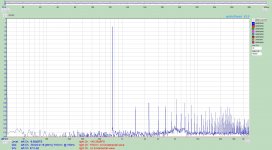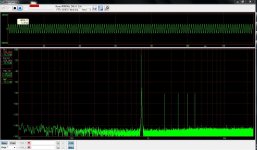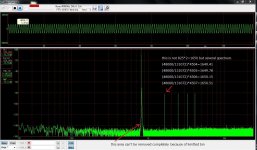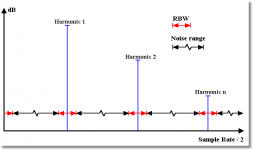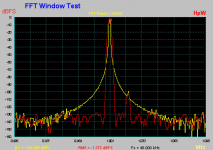I know lol - and I doubt it....
Even Focusrite quote -106dB (A Weighted) for the line input on the Scarlett 2i2.
I've often wondered how the software determines it's ~-140dB
I do run the input gain very, very low though, to maximise the SNR.
Sure you do not mix up FFT-noise-floor with absolute noise level over audio bandwidth? With ARTA I see similar low noise floor, at the same time the weighted noise level is about -106dB.
Last edited:
I know lol - and I doubt it....
Even Focusrite quote -106dB (A Weighted) for the line input on the Scarlett 2i2.
I've often wondered how the software determines it's ~-140dB
I do run the input gain very, very low though, to maximise the SNR.
I don't know much about Audio Tester. I wonder your attached file is not Dist but Mod Dist which means Modulation Distortion ?
Attached is my measurement and pretty correct.
Attachments
A validation routine would like like this:
1) calibrate sensitivity with a known 1KHz signal
2) measure noise floor in a known band with
a) ADC input shorted
b) DAC connected to ADC and DAC at digital zero
3) loopback with test signal with 5 harmonics all at -70 dB
4) Test with ultra low distortion external oscillator
This should create a baseline and show where the systems will disagree on signals.
1) done. Compared Levels with the Keithley DMM.
2a) fireface ucx, fs=48kHz, 24bit, 131072points, 4sec, measurement-BW is 20Hz~24kHz
2b) fireface ucx in loopback AOUT1->AIN5, same parameters, Output Level = 0
3) looping this .wav file test signal with mathematical THD = 0.070711% / -63.010dB
Baudline wav-file analysis:
Virtins measurement with Fireface in the loop, approx 1m Cordial CMN220:
Same testsignal Fireface AOUT1 -> QA041:
4) Victor's 1kHz Oszillator lastest rev., E3631A supply, FFT parameters as before
without averaging:
with 5 averages:
The Victor Osc. dierctly fed into the QA401 with a RCA->BNC adaptor:
We are getting somewhere... but i still doubt the software THD+N figures. Feeback welcome
Attachments
-
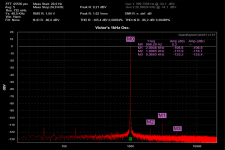 20170708_victor_1Vrms_qa401_hann_48k_5avg_01.png220.8 KB · Views: 535
20170708_victor_1Vrms_qa401_hann_48k_5avg_01.png220.8 KB · Views: 535 -
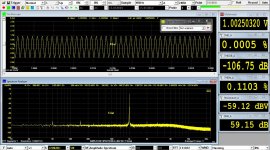 20170708_ffucx-ain5_Victor1kHz1Vrms_virtins_hann_48k_5avg_01.JPG243.5 KB · Views: 546
20170708_ffucx-ain5_Victor1kHz1Vrms_virtins_hann_48k_5avg_01.JPG243.5 KB · Views: 546 -
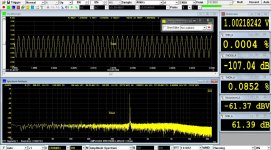 20170708_ffucx-ain5_Victor1kHz1Vrms_virtins_hann_48k_01.JPG248.2 KB · Views: 542
20170708_ffucx-ain5_Victor1kHz1Vrms_virtins_hann_48k_01.JPG248.2 KB · Views: 542 -
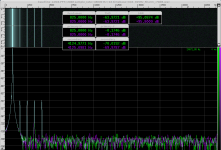 825Hz_5harm_-70dB_baudline_analysis.png282.1 KB · Views: 541
825Hz_5harm_-70dB_baudline_analysis.png282.1 KB · Views: 541 -
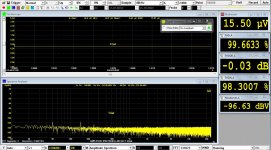 20170708_ffucx-ain5_noisefloor-ain5-aout1-loopback-0V_virtins_hann_48k_01.JPG214.6 KB · Views: 599
20170708_ffucx-ain5_noisefloor-ain5-aout1-loopback-0V_virtins_hann_48k_01.JPG214.6 KB · Views: 599 -
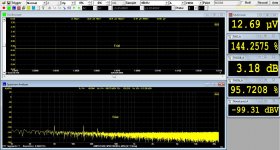 20170708_ffucx-ain5_noisefloor-ain5-shorted_virtins_hann_48k_01.JPG198.6 KB · Views: 557
20170708_ffucx-ain5_noisefloor-ain5-shorted_virtins_hann_48k_01.JPG198.6 KB · Views: 557 -
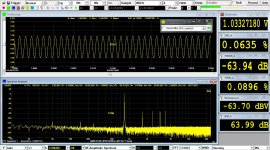 20170708_ffucx-ain5_825HzTestSignalat1Vrms_virtins_hann_48k_01.JPG252.6 KB · Views: 572
20170708_ffucx-ain5_825HzTestSignalat1Vrms_virtins_hann_48k_01.JPG252.6 KB · Views: 572 -
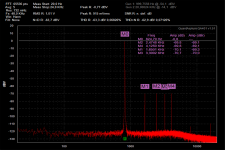 20170708_825HzTestSignal_ffucx-aout1_qa401_hann_48k_5avg_01.png227.1 KB · Views: 540
20170708_825HzTestSignal_ffucx-aout1_qa401_hann_48k_5avg_01.png227.1 KB · Views: 540
I don't know much about Audio Tester. I wonder your attached file is not Dist but Mod Dist which means Modulation Distortion ?
Attached is my measurement and pretty correct.
Yes, I believe that AudioTester* was measuring modulation distortion in my screen dumps - however you'll note that the distortion was 0.0000% which is probably incorrect.
I seem to have quite a few issues with AudioTester and the Asio* driver in particular on my PC - I have no idea why this is, as the other software I use (with the exception of RMAA) all work fine with the Asio* driver.
*this is the Focusrite supplied Asio driver.
*Although I like AudioTester, I find it rather confusing (and frustrating) to use at times - the scales and settings change each time you switch to a different measurement screen, so I find myself constantly resetting the max. / min. scales and various other parameters, as it doesn't 'remember' these settings between screens.
Same test setup: 825Hz test signal loopbacked through the FireFace UCX.
This time recorded with WaveSpectra at 48k/24bit/hanning/131072pts:
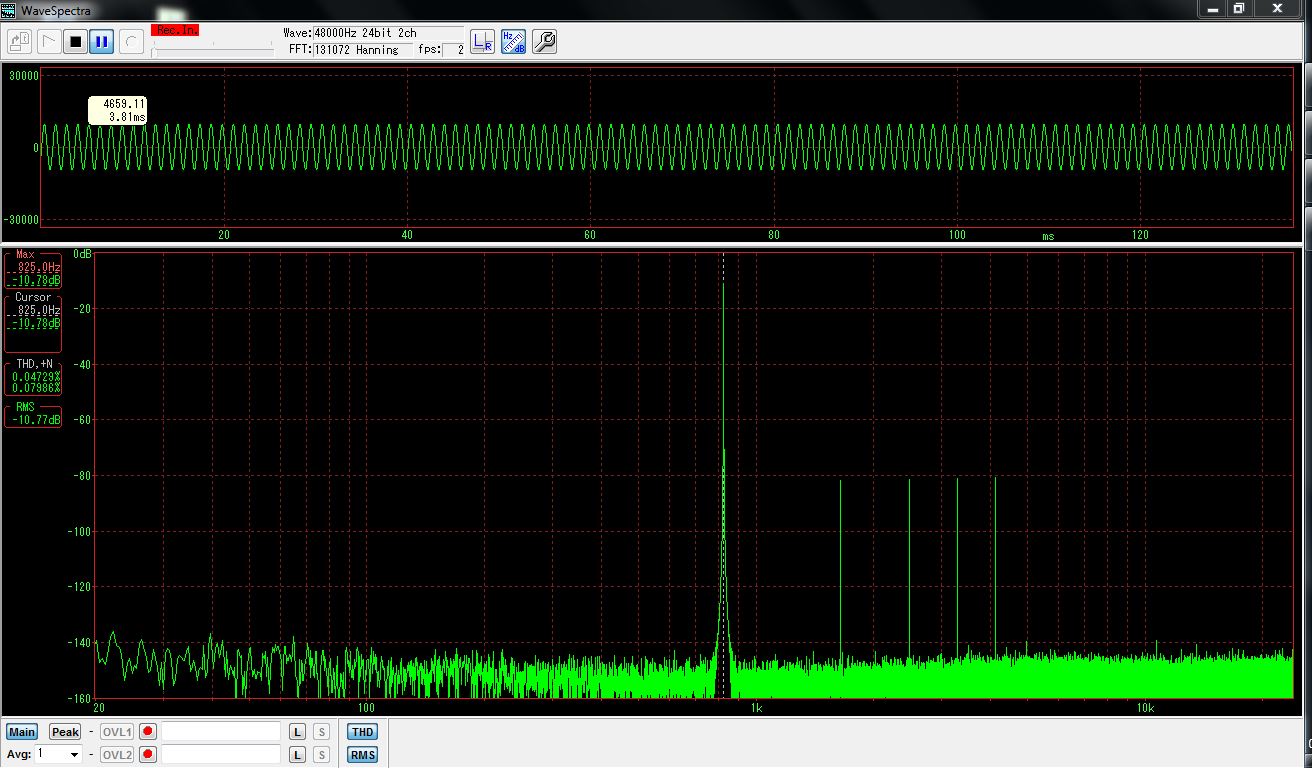
Cursoring out the 5 peaks retreives:
f0 = 0
f1 = -70,06
f2 = -69,88
f3 = -69,98
f4 = -69,97
A rough calculation with my oldschool casio results in approx 0.0638% THD.
WaveSpectra computes 0.0473% THD. WTF? In this case THD should be obvious!
Please don't get me wrong. I do not try to achieve the lowest THD possible, I am trying to achieve a reliable THD(+N) measurement results in the first step.
This time recorded with WaveSpectra at 48k/24bit/hanning/131072pts:
Cursoring out the 5 peaks retreives:
f0 = 0
f1 = -70,06
f2 = -69,88
f3 = -69,98
f4 = -69,97
A rough calculation with my oldschool casio results in approx 0.0638% THD.
WaveSpectra computes 0.0473% THD. WTF? In this case THD should be obvious!
Please don't get me wrong. I do not try to achieve the lowest THD possible, I am trying to achieve a reliable THD(+N) measurement results in the first step.
Attachments
The modulation distortion will indeed be very low, if you only have one tone present.Yes, I believe that AudioTester* was measuring modulation distortion in my screen dumps - however you'll note that the distortion was 0.0000% which is probably incorrect.
I seem to have quite a few issues with AudioTester and the Asio* driver in particular on my PC - I have no idea why this is, as the other software I use (with the exception of RMAA) all work fine with the Asio* driver.
*this is the Focusrite supplied Asio driver.
*Although I like AudioTester, I find it rather confusing (and frustrating) to use at times - the scales and settings change each time you switch to a different measurement screen, so I find myself constantly resetting the max. / min. scales and various other parameters, as it doesn't 'remember' these settings between screens.
I just made a quick test with audioTester on the RTX6001. With a 1 kHz tone at -2.26dB in, I measured -120.8 dB (0.0001%) THD, and -151.5 dB Mod. Dist. The latter gets truncated to 0.0000% (would be 0.0000027%).
I have had very good experience with audioTester and ASIO. But I don't have a Focusrite. I have mostly worked with an M-Audio Delta 1010 LT (earlier), Mini DSP USBStreamer and lately of course the RTX6001.
I clearly prefer the ASIO interface compared to having Windows interfering with the audio.
You are right that the settings are separate for the different measurement types in audioTester. This may, or may not, be an advantage, depending on how you use it and probably down to personal preference.
The modulation distortion will indeed be very low, if you only have one tone present.
Yes realised that. I plan to re-test now that I have the software working correctly again. (solution - delete AudT30d.ini)
I just made a quick test with audioTester on the RTX6001. With a 1 kHz tone at -2.26dB in, I measured -120.8 dB (0.0001%) THD, and -151.5 dB Mod. Dist. The latter gets truncated to 0.0000% (would be 0.0000027%).
0.0000027% still seems incredibly low? (this is a question not an argument!)
I have had very good experience with audioTester and ASIO. But I don't have a Focusrite. I have mostly worked with an M-Audio Delta 1010 LT (earlier), Mini DSP USBStreamer and lately of course the RTX6001.
I clearly prefer the ASIO interface compared to having Windows interfering with the audio.
I also prefer the ASIO interface as a general rule, but AudioTester does seem to have intermittent issues with it - but I'm happy to accept that might be vendor issues (in my case Focusrite) however all other products work just fine...
You are right that the settings are separate for the different measurement types in audioTester. This may, or may not, be an advantage, depending on how you use it and probably down to personal preference.
I wouldn't mind if it saved the settings for each individual activity, but it doesn't!
I appreciate you can use presets which helps - but having the ability to remember settings between activities would be a really useful feature.
The QA401 THD+N numbers are suspect. I brought that up to Matt and he is looking into it.
It seems the software packages are able to get accurate readings on known distortion levels. Thats a start. Untangling internal distortion limits is a separate issue. A few data points- the Victor oscillators distortions are in the -140 dB or better range. They are really below what can be measured using a traditional analyzer and well below anything an ADC can measure. Any harmonics seen with one are from the ADC side. With that knowledge it possible to separate the DAC distortions from the ADC distortions. Until recently the better ADC chips were all better than the DAC chips. Next point- All these ADC/DAC devices have their optimum distortion between -10 and -20 dB. But that compromises the SNR/DR so its important to understand what you are looking at. A high resolution FFT (I use 1 million points for this stuff when I need to find those lower harmonics. ) but below -110 dB they may not be accurate levels. Many error contributors and you should validate any measurements that low. Validation of those low measurement accuracies is not easy.
The noise in an individual bin relates to its bandwidth and comparing the noise floor plot to a measured noise floor is not useful The software does an RMS sum of all the bins adjusted by the weighting factor. Matching that to standards also requires understanding the standards, weightings and bandwidth. The traditional analyzer would have a 400 Hz HP filter and 30 KHz and 80 KHz LP filters. A 20 KHz LP filter to deal with digital aliasing has become more common lately.
As a reference point SOTA THD+N performance is in the -117 dB range and mostly limited by the noise of the input circuitry of the analyzer. And that is at a level of around 2-3V. Higher or lower ether the input attenuator or the noise of the amplifier degrades the number.
I'll try to duplicate these measurements with my hardware this week. It could be formidable with all the permutations but deciding which software to use is important. There are lots and they all have limitations and learning curves.
A bunch of important considerations on this:
1) Know how to use your tools. Know their limitations and when they are not accurate.
2) Know what you are looking for and at. If the numbers seem wrong they probably are (viz. -85 dB THD+N on the QA401)
3) Be prepared for the PC to Analyzer to software connections to be unstable. Somedays I just pack it in. . .
I have been using this to connect ASIO devices to WMA software and it seems to work really well : VB-Audio Hi-Fi Cable VB-Audio Virtual Apps Counterintuitively use the lower settings for it to work.
It seems the software packages are able to get accurate readings on known distortion levels. Thats a start. Untangling internal distortion limits is a separate issue. A few data points- the Victor oscillators distortions are in the -140 dB or better range. They are really below what can be measured using a traditional analyzer and well below anything an ADC can measure. Any harmonics seen with one are from the ADC side. With that knowledge it possible to separate the DAC distortions from the ADC distortions. Until recently the better ADC chips were all better than the DAC chips. Next point- All these ADC/DAC devices have their optimum distortion between -10 and -20 dB. But that compromises the SNR/DR so its important to understand what you are looking at. A high resolution FFT (I use 1 million points for this stuff when I need to find those lower harmonics. ) but below -110 dB they may not be accurate levels. Many error contributors and you should validate any measurements that low. Validation of those low measurement accuracies is not easy.
The noise in an individual bin relates to its bandwidth and comparing the noise floor plot to a measured noise floor is not useful The software does an RMS sum of all the bins adjusted by the weighting factor. Matching that to standards also requires understanding the standards, weightings and bandwidth. The traditional analyzer would have a 400 Hz HP filter and 30 KHz and 80 KHz LP filters. A 20 KHz LP filter to deal with digital aliasing has become more common lately.
As a reference point SOTA THD+N performance is in the -117 dB range and mostly limited by the noise of the input circuitry of the analyzer. And that is at a level of around 2-3V. Higher or lower ether the input attenuator or the noise of the amplifier degrades the number.
I'll try to duplicate these measurements with my hardware this week. It could be formidable with all the permutations but deciding which software to use is important. There are lots and they all have limitations and learning curves.
A bunch of important considerations on this:
1) Know how to use your tools. Know their limitations and when they are not accurate.
2) Know what you are looking for and at. If the numbers seem wrong they probably are (viz. -85 dB THD+N on the QA401)
3) Be prepared for the PC to Analyzer to software connections to be unstable. Somedays I just pack it in. . .
I have been using this to connect ASIO devices to WMA software and it seems to work really well : VB-Audio Hi-Fi Cable VB-Audio Virtual Apps Counterintuitively use the lower settings for it to work.
Gentlemen, thanks for your posts, they are educating me and others, keep up the good work.
Demian, in my research one of the measurement guru's here has posted on another forum that different software packages have different results with the same soundcard and set-up.
In your testing could you test the RTX with different software packages that you are familiar with and report back to us? Maybe the same distortion test, the same noise level test and others, all on a device you are familiar with.
This would help those of us trying to make up our minds which software to invest in a lot.
tia,
dennis h
Demian, in my research one of the measurement guru's here has posted on another forum that different software packages have different results with the same soundcard and set-up.
In your testing could you test the RTX with different software packages that you are familiar with and report back to us? Maybe the same distortion test, the same noise level test and others, all on a device you are familiar with.
This would help those of us trying to make up our minds which software to invest in a lot.
tia,
dennis h
Same test setup: 825Hz test signal loopbacked through the FireFace UCX.
This time recorded with Wave Spectra at 48k/24bit/hanning/131072pts:

Cursoring out the 5 peaks retreives:
f0 = 0
f1 = -70,06
f2 = -69,88
f3 = -69,98
f4 = -69,97
A rough calculation with my oldschool casio results in approx 0.0638% THD.
WaveSpectra computes 0.0473% THD. WTF? In this case THD should be obvious!
Please don't get me wrong. I do not try to achieve the lowest THD possible, I am trying to achieve a reliable THD(+N) measurement results in the first step.
Yes, you are correct. This is not accurate result.
From HP of Wave Spectra, there is inevitable reason for this.Software calculates THD with the most close spectrum of harmonics.Unless you use coherent sampling, harmonics and multiple of bin by integer doesn't coincide.So, software uses the most close one, which makes error. That's why THD is less than real value.
On the contrary, noise power usually becomes more than real one because removal of fundamental skirt is not adequate.Please see attached.I roughly estimate THD is -64dBFS(0.063%) and THD+N is also -64dBFS.Noise power of this case is almost -100dBFS.It matters nothing to THD+N.
Attachments
IMHO, the calc's has to be as given within the RBW (resolution bandwidth) picture...
Finally there are two or more problems regarding the RBW :
:
1. LDO needs some larger RBW for the first harmonic
2. On digital world, a spurious signal could be some bin's apart and would be masked
3. For DSD a bandwidth range is required, otherwise noise above 20kHz made the calculation
just my 2 cents
hp
Finally there are two or more problems regarding the RBW
1. LDO needs some larger RBW for the first harmonic
2. On digital world, a spurious signal could be some bin's apart and would be masked
3. For DSD a bandwidth range is required, otherwise noise above 20kHz made the calculation
just my 2 cents
hp
Attachments
I agree, especially true when the source is not locked to the ADC oscillator and/or is analog. The harmonic measurement window needs to be larger and at the same time the area blocked around the fundamental needs to be larger for analog oscillators or you get the QA401 problem.
I agree, especially true when the source is not locked to the ADC oscillator and/or is analog. The harmonic measurement window needs to be larger and at the same time the area blocked around the fundamental needs to be larger for analog oscillators or you get the QA401 problem.
I cannot/will not talk to faulty competition products.. good engineering is/was always an art
Hp
I think the QA401 problem is from using the internal generator as a source, and not testing with external sources. Further, it was not an issue in older versions of the software so possibly something got messed up at some point.
Good software is more than art- its a lot of tedious testing and verification as you have demonstrated.
Good software is more than art- its a lot of tedious testing and verification as you have demonstrated.
Good software is more than art- its a lot of tedious testing and verification as you have demonstrated.
Thank you for the hat
The pain is only: All are thinking, SW is freeware
even the man power behind is much larger than a simple "putting things together" HW (see Chinese gear).
And than after years, implemented things get bigger and required understanding get/is lost.
Did lately some DSD Generator test using an AP Sys-2722... gee, the FFT sample size gets 32k as a maximum and the settings
Hp
Thank you very much for all the valuable explanation. The "odd" test fundamental of 825Hz was chosen by me to investigate all those irregularities. My signal processing/analysis lectures were quite a long time ago this freshens a lot of stuff up for me 
Now, we identified the fundamental problems in FFT analysis and know how to overcome these issues: What can be done to achieve accurate noise and THD+N readings?
Basically, from a "test-instrument" I expect it to show reliable readings independent from the input signal properties. Maybe I should skip the software route and opt for a traditional analogue analyzer .
.
Now, we identified the fundamental problems in FFT analysis and know how to overcome these issues: What can be done to achieve accurate noise and THD+N readings?
Basically, from a "test-instrument" I expect it to show reliable readings independent from the input signal properties. Maybe I should skip the software route and opt for a traditional analogue analyzer
- Status
- This old topic is closed. If you want to reopen this topic, contact a moderator using the "Report Post" button.
- Home
- Design & Build
- Equipment & Tools
- Analyzer Software Overview
